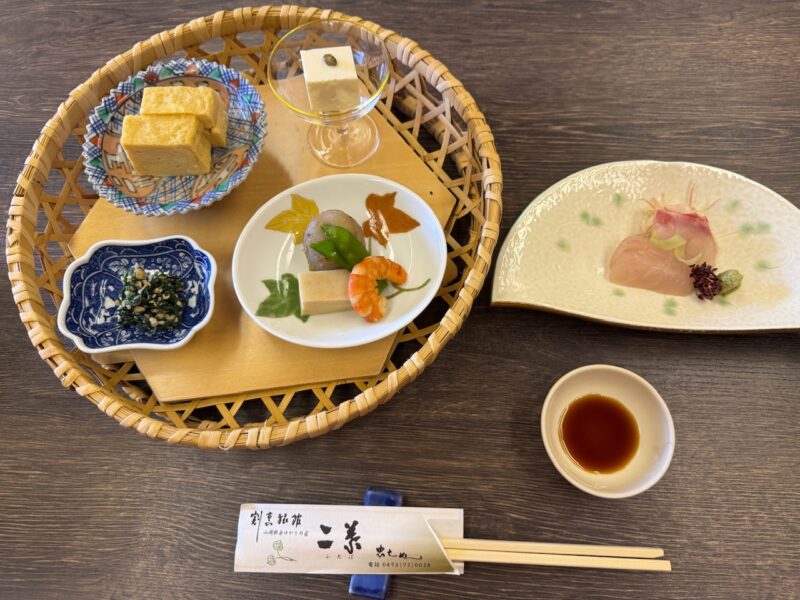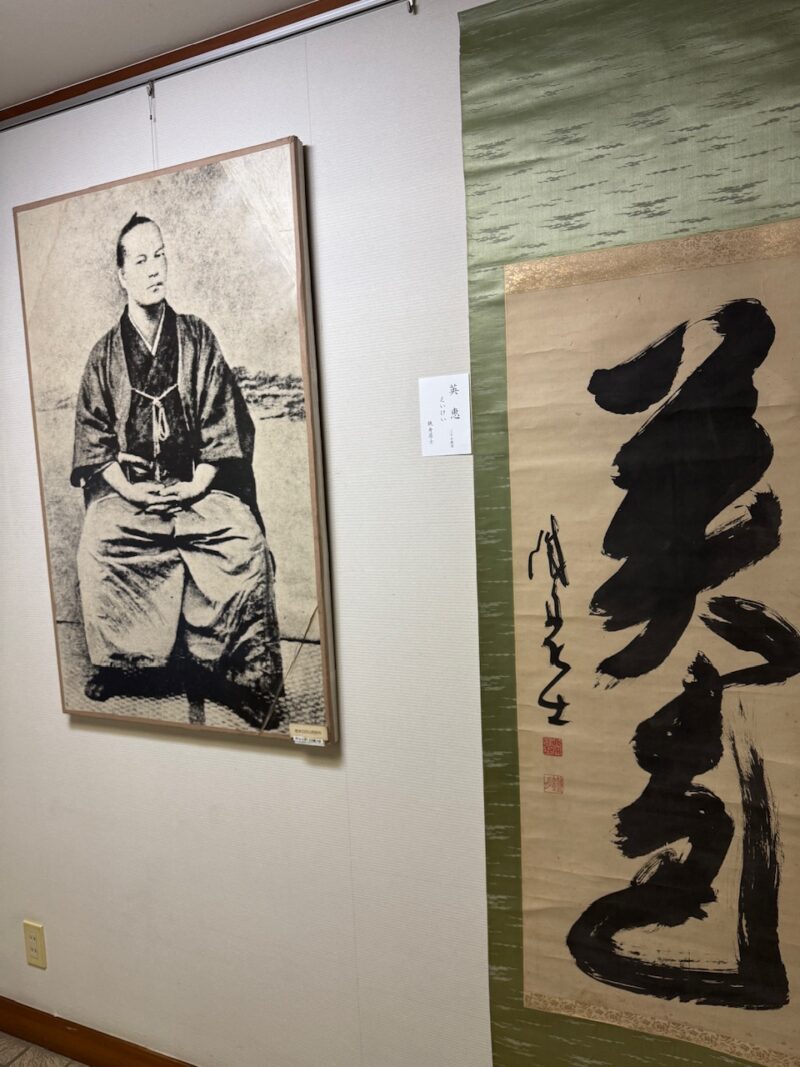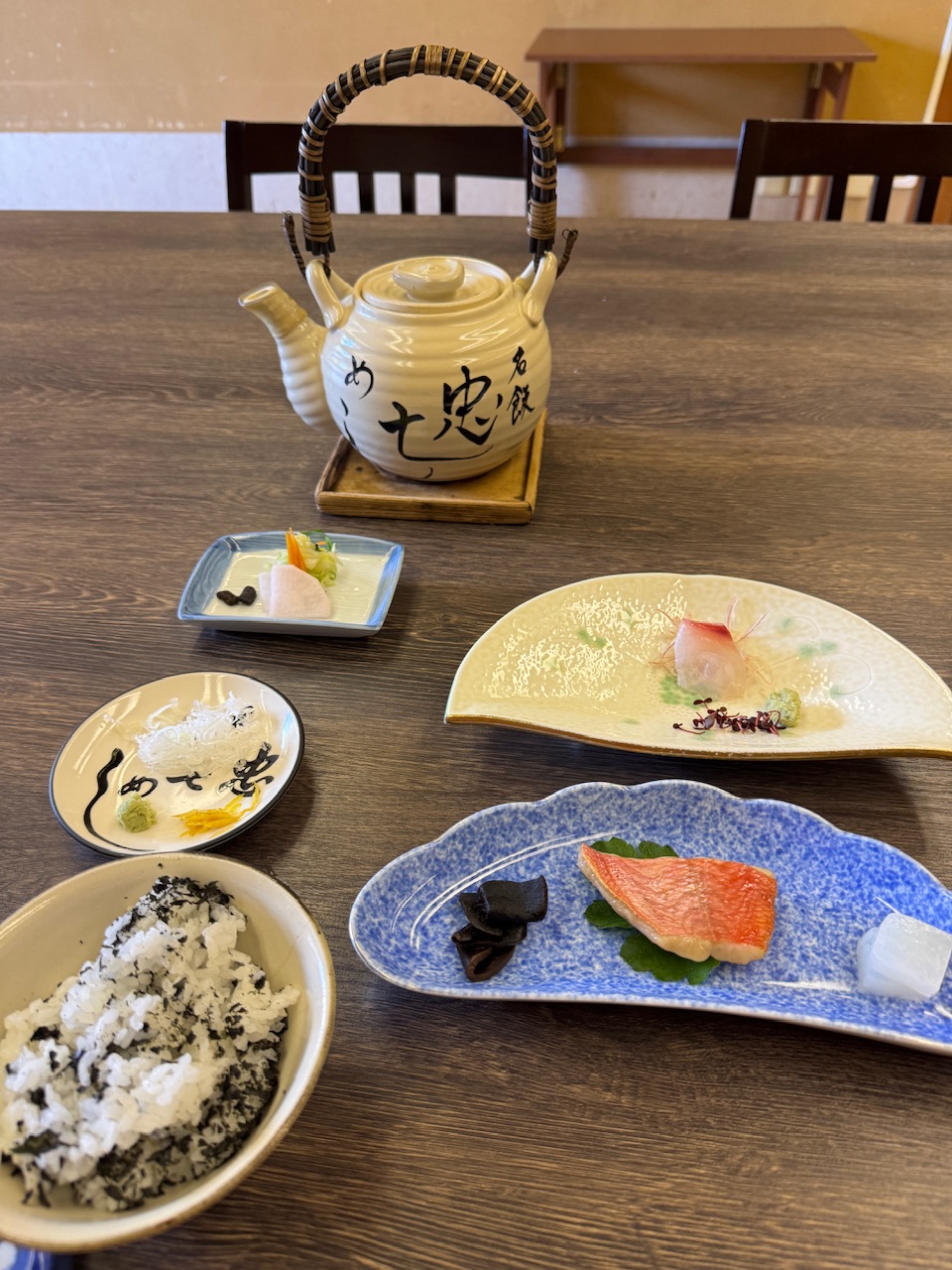埼玉県比企郡小川町にある割烹旅館「二葉」の「忠七めし」に挑戦して参りました。
何しろ、「日本五大名飯」の一つと言われております。日本五大名飯とは、昭和14年(1939年)、宮内省(現宮内庁)が選出したそうで、深川めし(東京都)、忠七めし(埼玉県)、かやくめし(大阪府)、さよりめし(岐阜県)、うずめ飯(島根県)を指します。
私は、東京の深川めしと大阪のかやくめしは食したことはありましたが、他の五大名飯は未体験でした。今回の忠七めしも、初めてでした。
幕末の偉人、「三舟」の一人で、江戸城無血開城に貢献した山岡鉄舟が考案したといわれております(三舟のあと二人は、勝海舟と高橋泥舟)。鉄舟は、天保7年(1836年)、江戸本所に御蔵奉行・小野朝右衛門高福の五男として生まれ、山岡家に養子に入りました。実家の小野家の知行地が、小川町にあったため、何度も同地に足を運び、常宿としたのが、寛延元年(1748年)に創業した割烹旅館「二葉」でした。鉄舟は、その八代目当主八木忠七に対して、「調理に禅味を盛れ」と示唆したことで考案されたのが忠七めしだといわれております。

そんな歴史と伝統の話を聞かされると、自ずと肩に力が入ってドキドキしてしまいますね(笑)。しかし、実際に食してみますと、確かに高級会席料理ではありますが、「単なるお茶漬けじゃん」と思ってしまいました。
というのも、「二葉」は、創業277年も誇る老舗割烹旅館で、敷居が異様に高く、ランチでもお値段が高めです。私は一番安い「花籠御膳」を予約して注文したのですが、税抜きで2800円、消費税とサービス料(140円)を加えると3234円になりましたからね。
でも、そんなこと言ってはいけませんね。敷居が高いのではなく、格式が高いと言わなければいけません。1階には、山岡鉄舟の書や写真パネルを飾った展示室もありましたし、見事な庭園もあります。現在、宿泊までやっていないようですが、日帰り入浴プランもあります。ミニコンサートや観月会などの催しもあります。恐らく、武蔵国で、一、二位を争う歴史と伝統のある割烹旅館であることは確かです。
怪しげな中年のアベックと同室
ランチは2階の15畳ほどの個室に通されましたが、三つのテーブルがあり、私は真ん中で、右隣は、私の食事中はどなたもいらっしゃいませんでしたが、左隣は、少し怪しげな中年のアベック(死語)さんでした。お二人とも50代後半という感じでしたので、中年ではなく、初老かもしれませんが…。
男性の方がよく喋り、「ここは、昔は100人ぐらい芸者を抱えていたんだぜ」とか「恐らく、ここらでは、小川町、寄居町、武蔵嵐山町…を含めてナンバーワンだろうなあ」とか、「ここは山岡鉄舟の馴染みの店で、鉄舟こそが江戸城無血開城を、西郷隆盛と直談判して決めたんだよ。勝海舟なんて、実は、何もしてない」などと彼女に蘊蓄を傾けておりました。
まさか、隣りで怪しげなブロガーが聞き耳を立てているとは、彼も想像だにしなかったことでしょう(笑)。
でも、私も彼の意見に大賛成ですね。江戸無血開城の立役者として、勝海舟が一番に挙げられますが、慶應4年(1868年)、将軍徳川慶喜の命で、決死の覚悟で駿府にいた西郷隆盛の屯所に乗り込み、西郷との直談判で江戸無血開城の基本条件五カ条(徳川家存続他)について合意を取り付けた人こそが山岡鉄舟でした。西郷は「金もいらぬ、名誉もいらぬ、命もいらぬ人は始末に困るが、そのような人でなければ天下の偉業は成し遂げられない」と、鉄舟のことを賞賛したほどでした。

江戸城無血開城に関しては、江戸・品川の薩摩藩邸での西郷隆盛と勝海舟との会談が「絵画」(結城素明「江戸開城談判」=聖徳記念絵画館)にもなって有名になりましたが、この絵画では西郷と海舟の二人しか描かれていません。しかし、山岡鉄舟もその場に同席したといいますから、何か作為的なものを感じます。

The Historical Connection Between Chūshichi Meshi (One of the Five Great Meals of Japan) and Yamaoka Tesshū
I took on the challenge of trying the “Chūshichi Meshi” at the traditional Japanese restaurant and ryokan (inn) Futaba in Ogawa Town, Hiki District, Saitama Prefecture.
After all, it is renowned as one of the “Five Great Meals of Japan”. These five meals were reportedly selected by the Imperial Household Ministry (now the Imperial Household Agency) in 1939 (Showa 14), and they are: Fukagawa Meshi (Tokyo), Chūshichi Meshi (Saitama), Kayaku Meshi (Osaka), Sayori Meshi (Gifu), and Uzume Meshi (Shimane).
I had previously tasted Fukagawa Meshi and Kayaku Meshi, but the others were new to me. This was my first time trying Chūshichi Meshi.
The dish is said to have been conceived by Yamaoka Tesshū, a great figure of the late Edo period and one of the “Three Boatmen” (along with Katsu Kaishū and Takahashi Deishū), who contributed to the peaceful surrender of Edo Castle. Tesshū was born in 1836 (Tenpō 7) as the fifth son of Ono Asaemon Takafuku, a magistrate of the Shogunate’s granary in Honjo, Edo, and was later adopted into the Yamaoka family. Since the Ono family’s chigyōchi (fief) was located in Ogawa Town, Tesshū frequently visited the area. His regular lodging there was the kappō ryokan Futaba, founded in 1748 (Kan’en 1). It is said that Tesshū suggested to the eighth owner, Yagi Chūshichi, to “incorporate the spirit of Zen into the cooking,” leading to the creation of Chūshichi Meshi.
When you hear stories of such history and tradition, you naturally tense up and feel a bit excited (laughs). However, upon actually eating it, I must confess I thought, “It’s just an upscale version of ochazuke (rice poured with tea/broth).”
You see, Futaba is a highly prestigious kappō ryokan boasting 277 years of history, and the threshold is unusually high—the prices, even for lunch, are steep. I ordered the least expensive item, the “Hanagome Gozen” lunch set, which I had reserved. It was \2,800 excluding tax, and adding consumption tax and the service charge (\140), it came to \3,234.
But I shouldn’t say that. It’s not a “high threshold,” it’s “high prestige.” On the first floor, there was an exhibition room displaying Yamaoka Tesshū’s calligraphy and photo panels, and they have a splendid garden. Although they don’t seem to offer overnight stays currently, they do have day-trip bathing plans and host events like mini-concerts and moon-viewing parties. It’s certainly one of the most historical and traditional kappō ryokans in Musashi Province.
For lunch, I was shown to a private room of about 15 tatami mats on the second floor. There were three tables; I was in the middle. The table on my right remained empty during my meal, but on my left was a somewhat suspicious middle-aged avec (a slightly outdated term for a couple). They both looked to be in their late 50s, so perhaps they were “early elderly” rather than “middle-aged”…
The man was quite talkative, pontificating loudly, “This place used to employ about 100 geisha back in the day,” and “This is probably number one around here, including Ogawa, Yorii, and Musashi-Ranzan towns,” and “This was Yamaoka Tesshū’s favorite spot. It was Tesshū himself who negotiated directly with Saigō Takamori to settle the peaceful surrender of Edo Castle. Katsu Kaishū actually did nothing.”
I doubt he ever imagined that a suspicious blogger was eavesdropping right next to him (laughs).
But I actually agree with his opinion wholeheartedly. Katsu Kaishū is often cited as the main architect of the peaceful surrender of Edo, but it was Yamaoka Tesshū who, ordered by Shogun Tokugawa Yoshinobu in 1868 (Keiō 4), resolutely rode into Saigō Takamori’s camp in Sunpu and secured the five basic conditions for the peaceful surrender (including the continuation of the Tokugawa house) through direct negotiation with Saigō. Saigō even praised Tesshū, saying, “A man who desires neither money, honor, nor life is troublesome, but without such men, no great national undertaking can be accomplished.”
The meeting between Saigō Takamori and Katsu Kaishū at the Satsuma domain residence in Shinagawa, Edo, concerning the peaceful surrender of Edo Castle, became famous and was immortalized in a painting (Yūki Somei’s “Edo Castle Opening Negotiation” at the Meiji Memorial Picture Gallery). However, only Saigō and Kaishū are depicted in this painting. Yet, it is said that Yamaoka Tesshū was also present, which makes one sense something contrived about the historical narrative.


コメント